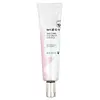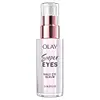What's inside
What's inside
 Key Ingredients
Key Ingredients

 Benefits
Benefits

 Concerns
Concerns

 Ingredients Side-by-side
Ingredients Side-by-side

Water
Skin ConditioningGlycerin
HumectantCyclopentasiloxane
EmollientPropanediol
SolventDimethicone
EmollientButyrospermum Parkii Butter
Skin ConditioningNiacinamide
Smoothing1,2-Hexanediol
Skin ConditioningCetearyl Olivate
Coco-Caprylate/Caprate
EmollientPolysorbate 20
EmulsifyingPolyacrylate-13
Sorbitan Olivate
EmulsifyingPolyisobutene
Dimethicone/Vinyl Dimethicone Crosspolymer
Skin ConditioningButylene Glycol
HumectantSodium Polyacrylate
AbsorbentDimethiconol
EmollientSqualane
EmollientPullulan
Dipotassium Glycyrrhizate
HumectantSodium Hyaluronate
HumectantPalmitoyl Glycine
CleansingMoringa Oleifera Seed Oil
EmollientCaprylic/Capric Triglyceride
MaskingHelianthus Annuus Seed Oil Unsaponifiables
EmollientLecithin
EmollientMadecassoside
AntioxidantCitric Acid
BufferingBeta-Glucan
Skin ConditioningSodium Ascorbyl Phosphate
AntioxidantAcetyl Hexapeptide-8
HumectantCopper Tripeptide-1
Skin ConditioningPalmitoyl Pentapeptide-4
Skin ConditioningAsiatic Acid
Skin ConditioningAsiaticoside
AntioxidantMadecassic Acid
Skin ConditioningAdenosine
Skin ConditioningXanthan Gum
EmulsifyingSorbitan Isostearate
EmulsifyingEclipta Prostrata Extract
Skin ConditioningAllantoin
Skin ConditioningCentella Asiatica Extract
CleansingMelia Azadirachta Leaf Extract
Skin ConditioningChamaecyparis Obtusa Leaf Extract
Skin ConditioningOriganum Vulgare Leaf Extract
Skin ConditioningSalix Alba Bark Extract
AstringentCinnamomum Cassia Bark Extract
MaskingLactobacillus/Soybean Ferment Extract
Skin ConditioningPortulaca Oleracea Extract
Skin ConditioningScutellaria Baicalensis Root Extract
AstringentEthylhexylglycerin
Skin ConditioningDisodium EDTA
Parfum
MaskingWater, Glycerin, Cyclopentasiloxane, Propanediol, Dimethicone, Butyrospermum Parkii Butter, Niacinamide, 1,2-Hexanediol, Cetearyl Olivate, Coco-Caprylate/Caprate, Polysorbate 20, Polyacrylate-13, Sorbitan Olivate, Polyisobutene, Dimethicone/Vinyl Dimethicone Crosspolymer, Butylene Glycol, Sodium Polyacrylate, Dimethiconol, Squalane, Pullulan, Dipotassium Glycyrrhizate, Sodium Hyaluronate, Palmitoyl Glycine, Moringa Oleifera Seed Oil, Caprylic/Capric Triglyceride, Helianthus Annuus Seed Oil Unsaponifiables, Lecithin, Madecassoside, Citric Acid, Beta-Glucan, Sodium Ascorbyl Phosphate, Acetyl Hexapeptide-8, Copper Tripeptide-1, Palmitoyl Pentapeptide-4, Asiatic Acid, Asiaticoside, Madecassic Acid, Adenosine, Xanthan Gum, Sorbitan Isostearate, Eclipta Prostrata Extract, Allantoin, Centella Asiatica Extract, Melia Azadirachta Leaf Extract, Chamaecyparis Obtusa Leaf Extract, Origanum Vulgare Leaf Extract, Salix Alba Bark Extract, Cinnamomum Cassia Bark Extract, Lactobacillus/Soybean Ferment Extract, Portulaca Oleracea Extract, Scutellaria Baicalensis Root Extract, Ethylhexylglycerin, Disodium EDTA, Parfum
Water
Skin ConditioningGlycerin
HumectantNiacinamide
SmoothingZea Mays Starch
AbsorbentCoco-Caprylate/Caprate
EmollientCaprylic/Capric Triglyceride
MaskingDimethicone
EmollientPanthenol
Skin ConditioningPalmitoyl Pentapeptide-4
Skin Conditioning3-O-Ethyl Ascorbic Acid
Skin ConditioningAloe Barbadensis Leaf Juice Powder
Skin ConditioningEthylhexylglycerin
Skin ConditioningHydroxyacetophenone
AntioxidantPolyglycerin-6
HumectantDimethiconol
EmollientStearyl Alcohol
EmollientCetyl Alcohol
EmollientBehenyl Alcohol
EmollientDisodium EDTA
Sodium Acrylate/Sodium Acryloyldimethyl Taurate Copolymer
Emulsion StabilisingCetearyl Olivate
Sorbitan Olivate
EmulsifyingPolyglyceryl-6 Laurate
EmulsifyingC15-19 Alkane
SolventSilica
AbrasivePhenoxyethanol
PreservativeTitanium Dioxide
Cosmetic ColorantMica
Cosmetic ColorantAvena Sativa Peptide
Skin ConditioningAscorbic Acid
AntioxidantWater, Glycerin, Niacinamide, Zea Mays Starch, Coco-Caprylate/Caprate, Caprylic/Capric Triglyceride, Dimethicone, Panthenol, Palmitoyl Pentapeptide-4, 3-O-Ethyl Ascorbic Acid, Aloe Barbadensis Leaf Juice Powder, Ethylhexylglycerin, Hydroxyacetophenone, Polyglycerin-6, Dimethiconol, Stearyl Alcohol, Cetyl Alcohol, Behenyl Alcohol, Disodium EDTA, Sodium Acrylate/Sodium Acryloyldimethyl Taurate Copolymer, Cetearyl Olivate, Sorbitan Olivate, Polyglyceryl-6 Laurate, C15-19 Alkane, Silica, Phenoxyethanol, Titanium Dioxide, Mica, Avena Sativa Peptide, Ascorbic Acid
Ingredients Explained
These ingredients are found in both products.
Ingredients higher up in an ingredient list are typically present in a larger amount.
This ingredient is an emollient, solvent, and texture enhancer. It is considered a skin-softener by helping the skin prevent moisture loss.
It helps thicken a product's formula and makes it easier to spread by dissolving clumping compounds.
Caprylic Triglyceride is made by combining glycerin with coconut oil, forming a clear liquid.
While there is an assumption Caprylic Triglyceride can clog pores due to it being derived from coconut oil, there is no research supporting this.
Learn more about Caprylic/Capric TriglycerideCetearyl Olivate is an emulsifier and texture enhancer. It is derived from the fatty acids of olive oil and Cetearyl alcohol, and is biodegradable.
As an emulsifier, it is used to prevent oils and waters from separating. It can also
Manufacturers use the name Olivem 1000. This ingredient has been found to preserve the natural microbiome of skin. Having a healthy microbiome helps keep our skin healthy and protects against harmful bacteria. This ingredient is grouped with Sorbitan Olivate under the name Olivem 1000.
Learn more about Cetearyl OlivateCoco-Caprylate/Caprate is created from fatty coconut alcohol, caprylic acid, and capric acid.
It is a lightweight emollient. Emollients create a thin barrier on the skin to trap moisture in. This helps keep your skin hydrated and soft.
Once applied, Coco-Caprylate/Caprate is absorbed quickly and leaves a silky feel.
Coco-Caprylate/Caprate may not be fungal acne safe.
Learn more about Coco-Caprylate/CaprateDimethicone is a type of synthetic silicone created from natural materials such as quartz.
What it does:
Dimethicone comes in different viscosities:
Depending on the viscosity, dimethicone has different properties.
Ingredients lists don't always show which type is used, so we recommend reaching out to the brand if you have questions about the viscosity.
This ingredient is unlikely to cause irritation because it does not get absorbed into skin. However, people with silicone allergies should be careful about using this ingredient.
Note: Dimethicone may contribute to pilling. This is because it is not oil or water soluble, so pilling may occur when layered with products. When mixed with heavy oils in a formula, the outcome is also quite greasy.
Learn more about DimethiconeDimethiconol is a silicone that resembles the popular dimethicone. Like other silicones, it is an emollient. Emollients create a thin film on skin to prevent moisture from escaping.
This ingredient helps to create a silky texture and improve spreadability. Due to its high molecular weight and thickness, it is often combined with cyclopentasiloxane.
Disodium EDTA plays a role in making products more stable by aiding other preservatives.
It is a chelating agent, meaning it neutralizes metal ions that may be found in a product.
Disodium EDTA is a salt of edetic acid and is found to be safe in cosmetic ingredients.
Learn more about Disodium EDTAEthylhexylglycerin (we can't pronounce this either) is commonly used as a preservative and skin softener. It is derived from glyceryl.
You might see Ethylhexylglycerin often paired with other preservatives such as phenoxyethanol. Ethylhexylglycerin has been found to increase the effectiveness of these other preservatives.
Glycerin is already naturally found in your skin. It helps moisturize and protect your skin.
A study from 2016 found glycerin to be more effective as a humectant than AHAs and hyaluronic acid.
As a humectant, it helps the skin stay hydrated by pulling moisture to your skin. The low molecular weight of glycerin allows it to pull moisture into the deeper layers of your skin.
Hydrated skin improves your skin barrier; Your skin barrier helps protect against irritants and bacteria.
Glycerin has also been found to have antimicrobial and antiviral properties. Due to these properties, glycerin is often used in wound and burn treatments.
In cosmetics, glycerin is usually derived from plants such as soybean or palm. However, it can also be sourced from animals, such as tallow or animal fat.
This ingredient is organic, colorless, odorless, and non-toxic.
Glycerin is the name for this ingredient in American English. British English uses Glycerol/Glycerine.
Learn more about GlycerinNiacinamide is a multitasking form of vitamin B3 that strengthens the skin barrier, reduces pores and dark spots, regulates oil, and improves signs of aging.
And the best part? It's gentle and well-tolerated by most skin types, including sensitive and reactive skin.
You might have heard of "niacin flush", or the reddening of skin that causes itchiness. Niacinamide has not been found to cause this.
In very rare cases, some individuals may not be able to tolerate niacinamide at all or experience an allergic reaction to it.
If you are experiencing flaking, irritation, and dryness with this ingredient, be sure to double check all your products as this ingredient can be found in all categories of skincare.
When incorporating niacinamide into your routine, look out for concentration amounts. Typically, 5% niacinamide provides benefits such as fading dark spots. However, if you have sensitive skin, it is better to begin with a smaller concentration.
When you apply niacinamide to your skin, your body converts it into nicotinamide adenine dinucleotide (NAD). NAD is an essential coenzyme that is already found in your cells as "fuel" and powers countless biological processes.
In your skin, NAD helps repair cell damage, produce new healthy cells, support collagen production, strengthen the skin barrier, and fight environmental stressors (like UV and pollution).
Our natural NAD levels start to decline with age, leading to slower skin repair, visible aging, and a weaker skin barrier. By providing your skin niacinamide, you're recharging your skin's NAD levels. This leads to stronger, healthier, and younger looking skin.
Another name for vitamin B3 is nicotinamide. This vitamin is water-soluble and our bodies don't store it. We obtain Vitamin B3 from either food or skincare. Meat, fish, wheat, yeast, and leafy greens contain vitamin B3.
The type of niacinamide used in skincare is synthetically created.
Learn more about NiacinamideYou might know this ingredients as Matrixyl, a famous peptide.
Peptides are building blocks for protein. Palmitoyl Pentapeptide-4 consists of five amino acids. These amino acids include: 2 lysines, 2 threonines, and serine
This ingredients tells our body to create more collagen. Collagen is a protein that makes connective tissue. Boosting collagen production leads to a healthier skin barrier. Having a healthy skin barrier means having firm and hydrated skin.
Thus, Matrixyl may help improve the look of wrinkles.
Read more about other common types of peptides here:
Learn more about Palmitoyl Pentapeptide-4Sorbitan Olivate is created from the fatty acids in olive oil and sorbitol.
This ingredient is an oil in water emulsifier. It helps stabilize a product by preventing oils and waters from separating. Sorbitan Olivate also helps hydrate the skin.
Manufacturers sell sorbitan olivate under the name OliveM 1000. OliveM 1000 a multifunctional ingredient. It is self-emulsifying. According to a manufacturer, OliveM 1000 does not disrupt natural skin biome.
Due to its olive oil base, this ingredient may not be fungal-acne safe.
Learn more about Sorbitan OlivateWater. It's the most common cosmetic ingredient of all. You'll usually see it at the top of ingredient lists, meaning that it makes up the largest part of the product.
So why is it so popular? Water most often acts as a solvent - this means that it helps dissolve other ingredients into the formulation.
You'll also recognize water as that liquid we all need to stay alive. If you see this, drink a glass of water. Stay hydrated!
Learn more about Water